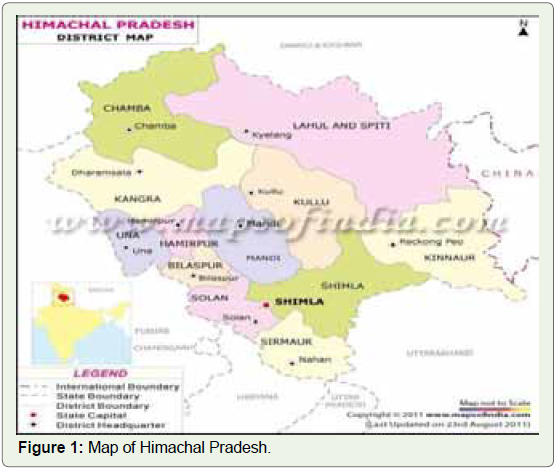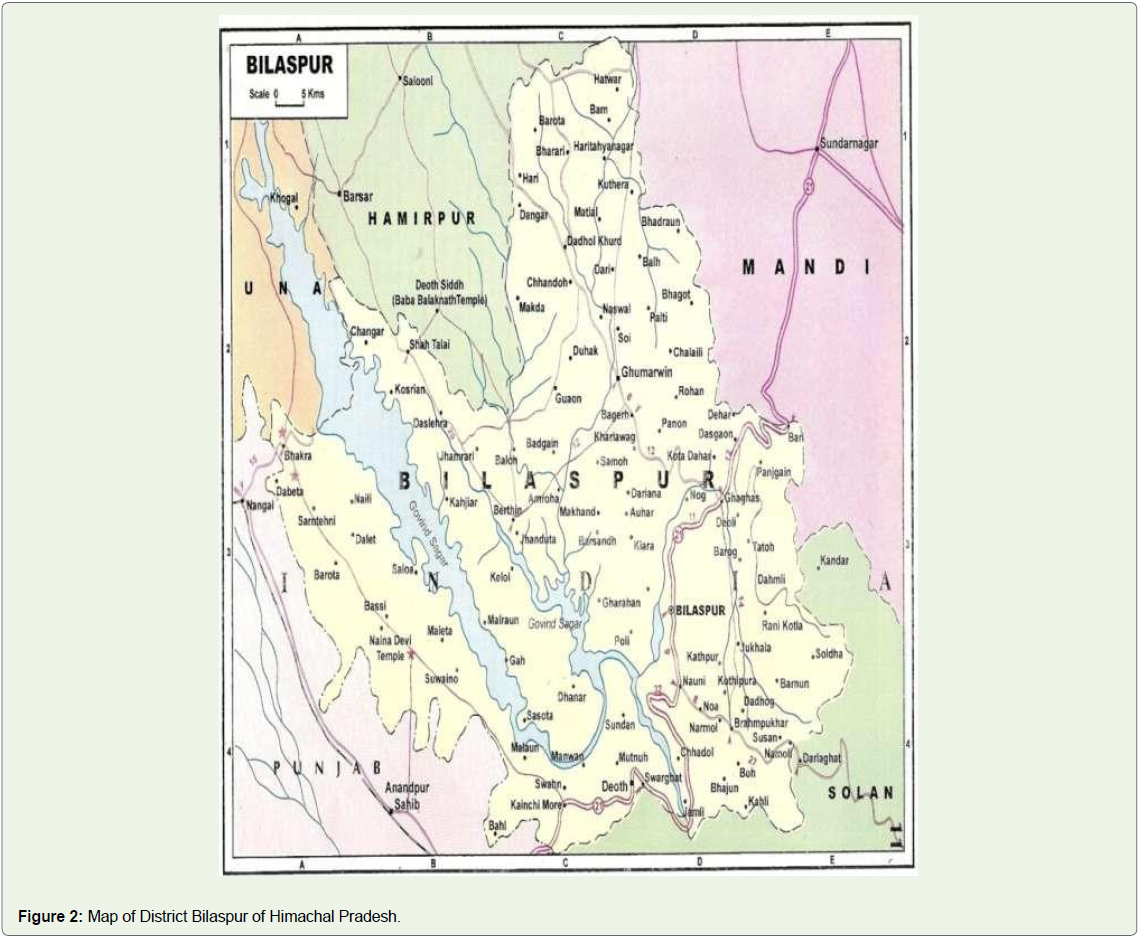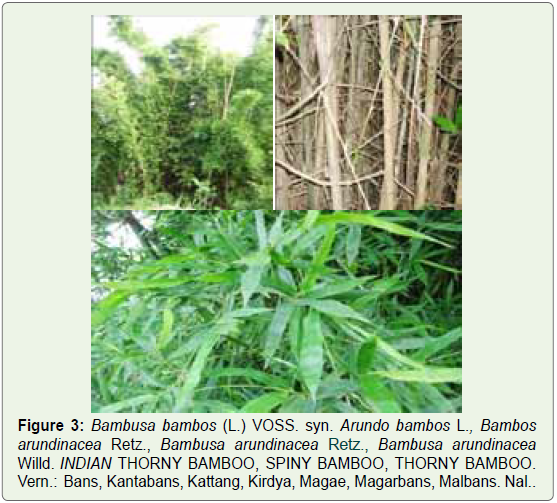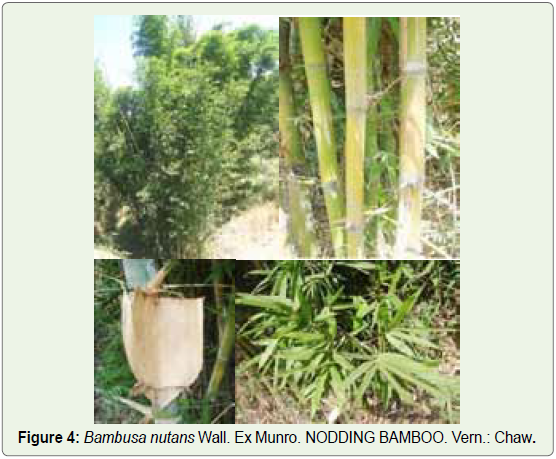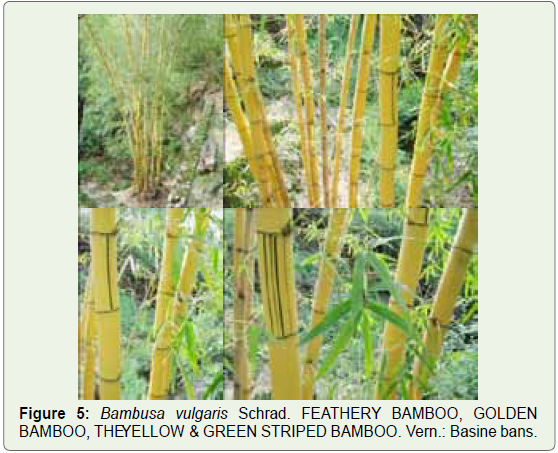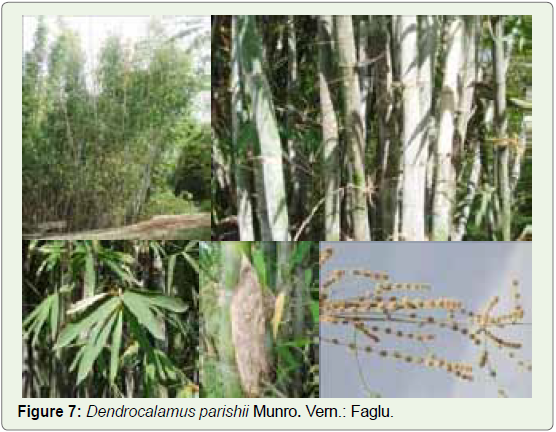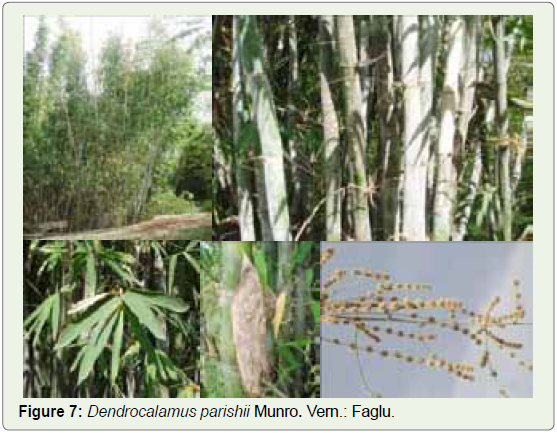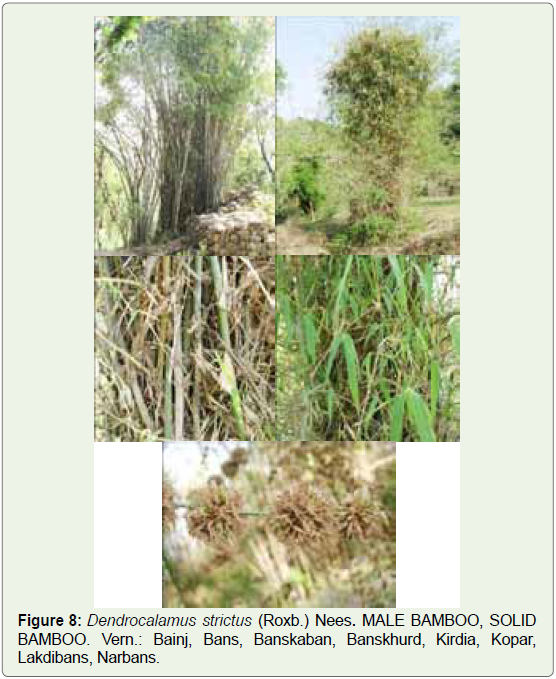Research Article
Bamboo Species of District Bilaspur of Himachal Pradesh, India
Kumar M*
Department of Botany, Govt. P.G. College, India
*Corresponding author: Kumar M, Associate Professor, Department of Botany, Govt. P.G. College Ghumarwin,
District Bilaspur, PIN 174021 (H.P.), India; Email: mahender2629@gmail.com
Copyright: © Kumar M. 2021. This is an open access article distributed under the Creative Commons Attribution License, which
permits unrestricted use, distribution, and reproduction in any medium, provided the original work is properly cited.
Article Information: Submission: 18/06/2021; Accepted: 28/07/2021; Published: 02/08/2021
Abstract
Bamboos are the perennial woody grasses, belonging to the family Bambusaceae. They are the clump forming plants arising from the underground
rhizomes. The stem (culm) is with distinct nodes and internodes. Bamboos are the fastest growing plants in the world. Himachal Pradesh is situated in the
Western Himalayan region of India. The district Bilaspur is located in Shivalik Hills, also known as the Outer Himalayas or Sub-Himalayan zone of Himachal
Pradesh. The climate of Shivalik Hills is suitable for the growth of different species of bamboos. Six species of bamboos viz. Bambusa bambos, Bambusa
nutans, Bambusa vulgaris, Dendrocalamus hamiltonii, Dendrocalamus parishii and Dendrocalamus strictus are reported form the territory of Bilaspur. The
aim of this paper is to identify the Bamboo Species of District Bilaspur of Himachal Pradesh.
Keywords
Bamboos; Bambusaceae; Culm; Western Himalaya; Shivalik Hills; Satluj (River)
Introduction
Bilaspur is the second smallest district of Himachal Pradesh,
having an area of 1167 Sq. KM. As well as it is also one of the twelve
districts of Himachal Pradesh. The altitude of Bilaspur varies from
290 metres to 1980 metres. It is surrounded by Hamirpur and Mandi
districts on the North, Mandi and Solan on the East, Solan district
and Punjab State on South while Una and Hamirpur districts on the
West side. The river Satluj flows through the district Bilaspur for
about 90 KM. This river enters the district Bilaspur at KARAHI KA
GHARAAT near the village Kasol (now-a-days famous for Koldam
Hydropower Station of 800 MW) and leaving it at the village NEILA
near the Bhakhra Dam (Hydropower Station have a total capacity
of 1325 MW) [Mamgain M.D. 1975, Himachal Pradesh District
Gazetteer- Bilaspur. Government of Himachal Pradesh, Shimla;
Google Search] [1].
The main objective of this paper is to identify the various
species of Bamboos of the district Bilaspur of Himachal Pradesh.
Their systematics, common names, vernacular names, citations, morphological features, flowering and fruiting seasons, places
of collection, habitat, their distribution in the World, India, and
Himachal Pradesh along with economic and ethnobotanical uses are
also included in this paper. Coloured photographs of these species
are taken during the field survey. Bamboos species are abundantly
present in the Sadar, Ghumarwin, Bharari and Jhandutta Forest
Ranges of the district Bilaspur. While in Swarghat and Kalol Forest
Ranges they are less abundant. This paper will motivate the people for
the conservation of bamboos because of their diverse uses.
Materials and Methods
Extensive field survey of the district Bilaspur has been
carried out in order to explore the different species of Bamboos.
Standard Procedures are adopted for the collection, preservation
and identification of various species of Bamboos. During the
field survey, their vegetative and floral characteristics are noted.
Coloured photographs of all the species are also taken in the field.
Herbarium mounts of these species are also prepared for record and
identification. While describing and identifying the different species of Bamboos, we strictly adhered to the terminologies used by Haris
and Haris (1994), Jain and Rao (1977), Polunin and Stainton (1984),
Stainton (1988) and Womersley (1981) [2-6]. Their nomenclature is
in accordance with the International Code of Nomenclature (ICN)
or MELBOURNE CODE, 2012, International Plant Names Index
(IPNI) [7], The Plant List (2013) [8] and Bannet (1987) [9]. The Natural
System of Classification of plants with latest amendments has been
followed in this paper (Figure 1 and 2).
Observations
In order to study the diversity of bamboos of the district Bilaspur,
its survey has been carried out during different seasons. A total of
six species belonging to two genera, all included in lone family i.e.
Bambusaceae are reported form the territory of Bilaspur. All the
species of bamboos are abundant in Sadar, Ghumarwin, Bharari and
Jhandutta Forest Ranges. However the species of bamboos are less
abundant in Swarghat and Kalol Forest Ranges. Bambusa vulgaris has been reported form the nursery garden of ACC Limited at Barmana.
Results and Discussions
Six species of bamboos viz. Bambusa bambos, Bambusa nutans,
Bambusa vulgaris, Dendrocalamus hamiltonii, Dendrocalamus
parishii and Dendrocalamus strictus are collected and identified
during the field survey of the district Bilaspur of Himachal Pradesh.
The various species of Bamboos have been described alphabetically
as under:-
1. Bambusa bambos (L.): Voss. Vilm. Blumengärtn. ed. 3. 1:
1189 1895. Bambusa arundinacea Willd. Sp. Pl. 2: 245. 1799; Kanjilal,
For, Fl. Chakrata, Dehradun & Saharanpur. 536. 1901; FF. 532.
1918. Bambusa
arundinacea Retz. Stewart, PP.251. 1869. Bambusa
arundinacea (Retz.) Willd. Polumin and Stainton, Fls. Himalaya.442.
1984. Family Bambusaceae: INDIAN THORNY BAMBOO, SPINY
BAMBOO, THORNY BAMBOO. Vern: Bans, Kantabans, Kattang,
Kirdya, Magae, Magarbans, Malbans. Nal. Figure 3.
Figure 3: Bambusa bambos (L.) VOSS. syn. Arundo bambos L., Bambos
arundinacea Retz., Bambusa arundinacea Retz., Bambusa arundinacea
Willd. INDIAN THORNY BAMBOO, SPINY BAMBOO, THORNY BAMBOO.
Vern.: Bans, Kantabans, Kattang, Kirdya, Magae, Magarbans, Malbans. Nal..
It is a tall thorny bamboo with crowded culms arising from stout
and branching rootstocks. Clump is graceful and curving. Culms: 20-
30 m in height, 15-18 cm in diameter, bright green shining; nodes
prominent, the lowest nodes rooting, the lower nodes with leafless,
spinescent, zigzag horizontal branches; internodes up to 45 cm long,
somewhat depressed near the base of the branches, 2.5-5 cm thick wall;
cavity small. Culm-sheaths: 30-38x22-30 cm, striate, orange-yellow,
thickly ciliated with golden hairs when young, otherwise glabrous,
rounded at the apex; blade 5-10 cm long, triangular, acuminate,
glabrous outside, matted with dark bristles within, margins wavy,
involute, thickly ciliate, auriculate; ligule narrow, entire or fringed
with pale hairs. Leaves: 18-20x2.5 cm, linear or linear-lanceolate,
glabrous above, glabrous or puberulous beneath, margins scabrous,
tip sharp and stiff, base rounded or oblique and ciliate near the
petiole; secondary longitudinal nerves 4-6 on either side of midrib,
with pellucid glands at intervals; petiole 2.5 mm long, swollen; leaf
sheath with short auricles, thickly ciliate when young, ligule short.
Inflorescence is an enormous panicle, occupying the whole culm.
Spikelets are glabrous, 1.3-2.5 cm long on branchlets, about 5 in a
cluster, lanceolate, acute; the lower flowers are bisexual, the upper
male and followed by 1-3 imperfect flowers. Involucral glumes 1-2
or sometimes absent, ovate-lanceolate, acute or mucronate, 5-8 mm
long, many-nerved, empty. Floral glumes are 3-7. Palea is sub- acute
with 2 ciliate keels. Lodicules are 3, ovate or sub-ovate, hyaline,
ciliate, ciliate, 1- 3-nerved. Stamens are slender, drooping; anthers
yellow, obtuse. Style is short. Grains are 5-8 mm long, oblong,
ending in a short beak formed by the base of the style, grooved on
one side. Flowering and Fruiting: Flower gregariously at intervals
of 30-32 years.
Specimens examined: Chandpur,12 July, 2010, Mahender. 48.
Distribution: Native of South India, Myanmar, Sri Lanka. India:
Sub-Himalayan tract, Himachal Pradesh, Uttarakhand. Himachal
Pradesh: Bilaspur. Altitude: up to 1200 m.
Economic and Ethnobotanical Uses:
Root is tonic; burnt
and applied to ringworm, bleeding gums and joint pains. Roots
are useful in skin diseases, burning sensations, strangury and
general debility. Stem and leaves are acrid, bitter, sour; cooling,
laxative; useful in burning sensations, blood diseases, biliousness,
leucoderma, inflammations, strangury, wounds and piles. Stem is
used for making rafters, poles, in mat making, domestic wares and
for paper pulp; young shoots are edible and pickled. Bamboo manna
or Banslochan or Tabashir is a silicious and crystalline substance
found in the interior of stems. It is rich in calcium, given to pregnant
women and children; sweet, cooling, acrid, with a flavor; aphrodisiac,
tonic; constipating; useful in blood diseases, asthma, bronchitis,
tuberculosis, fever, leprosy, jaundice, anaemia, strangury, burning
sensations, biliousness, thirst, ophthalmia and stomatitis; the burnt
powder is useful in syphilis. Leaves are sweet, astringent, cooling,
emmenagogue, ophthalmic, vulnerary, constipating, febrifuge; useful
in lumbago, haemorrhoids, diarrhoea, gonorrhoea, amenorrhoea,
dysmenorrhoea, wounds, skin diseases and fever. Leaves are also used
as fodder. Sprouts are pungent, acrid, laxative; useful in strangury;
causes burning sensation, increase cough. Seeds are acrid, sweet,
fattening, aphrodisiac, alexiteric; useful in biliousness, urinary
discharges; eaten during times of scarcity. Flower juice is good for
earache and deafness. (Watt, 1889-1893; Kirtikar and Basu, 1935;
Singh et al., 1983; Ambasta, 1986; Nayar et al., 1989; Warrier et al.,
1994; Joshi, 2000; Pullaiah, 2002; and Agarwal, 2003) [9-15].2. Bambusa nutans Wall. ex Munro. Trans. Linn. Soc. London 26:
92. 1868; FHP. 3: 859. 1984; Polunin & Stainton, Fls. Himalaya. 442.
1984. Bambusa nutans Wall. Kanjilal, For. Fl. Chakrata, Dehradun &
Saharanpur. 535. 1901; Brandis, Ind. Trees. 668. 1906; FF. 531. 1918.
Family Bambusaceae. NODDING BAMBOO. Vern.: Chaw. Figure 4.
Culms rising from a creeping rhizome, distant (not crowded),
6-17 m long, 3-8 cm in diameter, straight, graceful, without spiny
branches, bright green, glaucous when young; nodes not much raised,
hairy; internodes 37-45 cm long, thick walled, not shining. Culm
sheaths 15-23 cm long, roundedly truncate at top, with adpressed
black hairs on the back, scabrid after the hairs have fallen. Blade
varying in size, broad, acute, margins recurved, the base decurrent on the sheath, black-hairy within, with two large wavy densely-bristly
auricles; ligule narrow, dentate. Leaves 10-30 x 1.8-4 cm, scabrid
at the top along the midrib and margins, tip twisted, base rounded
or narrowed; secondary longitudinal nerves 7-10 on either side of
midrib; petiole 2.5 -5 mm long; sheath striate, produced into a falcate
auricle which is covered with long bristles. Inflorescence a stiff panicle
of spike-like braches which bear interrupted clusters of spikelets.
Spikelets are 1.8-2.5 cm long, glabrous, acute, empty glumes 2-3,
fertile flowers 3-5, followed by 2-3 imperfect flowers; axis (rachillum)
clavate; lodicules 3, fimbriate. Anthers are apiculate. Stigmas 2-3,
twisted. Grain is oblong, hairy top. Flowering and Fruiting: August-
October (Sporadically)
Specimens examined: Sungal, 22 Oct, 2012, Mahender. 347,348.
Distribution: Sub-Himalayan tract. India: Jammu to Assam
Himachal Pradesh: Kangra (DD). Altitude: up to 1700 m.
Economic and Ethnobotanical Uses: Leaves are used as fodder.
Culms are straight and strong; used for the production of mechanical
pulp. They are used for building purposes, as rafters and as shafts.
(Kanjilal, 1901; Parker, 1918; and Ambasta, 1986).
3. Bambusa vulgaris Schrad. Coll. Pl. 2: 26 1808; Brandis, Ind.
Trees 670. 1906; FF. 532.1918. Family Bambusaceae. FEATHERY
BAMBOO, GOLDEN BAMBOO, THE YELLOW & GREEN
STRIPED BAMBOO. Vern.: Basine bans. Figure 5.
Figure 5: Bambusa vulgaris Schrad. FEATHERY BAMBOO, GOLDEN
BAMBOO, THEY ELLOW & GREEN STRIPED BAMBOO. Vern.: Basine bans.
It is a large, tufted handsome bamboo, but clumps are not dense.
Culms unarmed, bright-yellow with narrow green stripes running the
length of the internodes and on alternate sides in adjacent internodes,
6-17 m high, internodes 25.4-45.2 cm long and 7.6-12.7 cm in diam.,
walls thin; culm sheaths 15-25 cm, brownish hairy outside; green
and yellow streaked at younger stage, top concavely truncate, blade
triangular and auricled at base. Leaves 30-41 x 2.5-5 cm; nerves 21-
39, transverse veins visible on lower surface, leaf sheath appressed
white hairy. Spikelets are compressed, palea thin. Style is long hairy.
Stigmas are 3, plumose.
Specimens examined: Barmana, 22 June, 2009, Mahender. 43.
India: Cultivated in gardens and run wild over warmer parts of
India, original home uncertain.
Economic and Ethnobotanical Uses: The bamboo is used
for scaffolding, roofing etc. Culms are used for building and other
purposes. Split culms are made into mats and baskets; also used for
paper making. Young buds consumed as a vegetable. Leaves are
cooling, their decoction is useful in fevers and sore throat. Culm is
soft and long fibred; a valuable source of paper pulp. Roots and young
shoots are emollient, diuretic and diaphoretic. Bark is astringent,
useful in haemorrhage, excessive menstruation, nausea and vomiting
(Singh et al., 1983; Ambasta, 1986; Agarwal, 2003; and Nautiyal and
Kaul, 2003).
4. Dendrocalamus hamiltonii Nees & Arn. ex Munro. FBI. 7:
405. 1896; Kanjilal, For. Fl. Chakrata, Dehradun & Saharanpur. 538.
1901; FS. 636. 1902, 1921; Brandis, Ind. Trees. 676. 1906; FF. 533.
1918; Polunin & Stainton, Fls. Himal. 441. 1984; FHP. 3: 859. 1984.
Family Bambusaceae. HAMILTONS BAMBOO. Vern.: Kaghsi
bans, Maggar. Figure 6.
Figure 6: Dendrocalamus hamiltonii Nees & Arn. Ex Munro. HAMILTONS
BAMBOO. Vern.: Kaghsi bans, Maggar.
It has broader leaves than Dendrocalamus strictus and the
globose heads of purple spikelets are not spinous. This bamboo forms
impenetrable thickets of stems (culms) up to 26 m with over-hanging
often horizontal branches. Stem (culm) 10-13 cm in diameter, dullgreen,
lower nodes marked with root-scars internodes 30-50 cm
long; (culm) stem-sheaths triangular, persistent, up to 30 cm long.
Branches on lower part of the stem seated on woody knobs the size of
a fist, and on these may be half- developed swollen buds with brown
sheaths. Leaves narrow-lanceolate, long-pointed, to 45 cm long by 13
cm wide, lanceolate, cuspidate, smooth above, rough beneath, main
lateral nerves 6-17 pairs, base unequal sided; petiole short; ligule
broad. Leaf sheaths with stiff hairs. Spikelets blunt, in dense, rounded
axillary clusters, 1.5-4 cm across, on stout unbranched stems. Bracts
are with ciliate margins. Stamens are 6. Grain is broadly ovoid,
beaked. Flowering and Fruiting: Sporadically.
Specimens examined: Bharari, 29 March, 2013, Mahender.
396,397.
Habitat: Wild or Cultivated. Distribution: Tropical Himalaya,
India, Burma, SE. Asia, Nepal. India: Himachal Pradesh to Arunachal
Pradesh, E. Himalaya, Assam. Himachal Pradesh: Hamirpur (DD),
Kangra (DD). Altitude: Up to 2000 m.
Economic and Ethnobotanical Uses: Employed for paper
making. Young culms used as vegetable in Assam, Bhutan and
Sikkim. Because of long internodes and large lumen, this bamboo
is particularly suitable for water conduits. It is also used for making
baskets, mats, screens. Stems are rather soft for building purposes,
as rafters and as shafts. (Kanjilal, 1901; Parker, 1918; and Ambasta,
1986).
5. Dendrocalamus parishii Munro. Trans. Linn. Soc. London 26:
149. 1868. Family Bambusaceae. Vern.: Faglu. Figure 7.
A perennial and caespitose bamboo; culms woody, erect with
terete internodes. Lateral branches dendroid. Ligule an eciliate
membrane. Inflorescence synflorescence and bractiferous, globose,
clustered at the nodes, dense, 1.5- 3 cm long, with glumaceous
subtending 6- 10 mm long bracts; buds axillary at the base of spikelets;
prophyllate below lateral spikelets; leafless between clusters. Fertile
spikelets sessile. Glumes 1- 2 empty, similar, persistent, shorter than
spikelet; lower glume 4 mm long, ovate, acute, coriaceous, without
keels, puberulous with hairy apex and ciliate margins; upper glumes 4
mm long, ovate, acute, chartaceous, with keels, puberulous with hairy
apex and ciliate margins. Florets 6 mm long, fertile lemma ovate,
chartaceous, without keel, 11-13 veined; lateral veins of lemma crossveined;
ciliate margins, acute apex, mucronate. Palea chartaceous;
2- keeled, uppermost without keels, keels ciliolate with pilose
surface. Lodicules are absent. Stamens 6; anthers tip with extended
connective; filaments united in a tube. Ovary is pubescent; stigma 1.
Fruits caryopsis, ovovoid. Flowering and Fruiting: March to June.
Specimens examined: Mihare, 21 April, 2012, Mahender.
398,399.
Habitat: Common in forest and waste land. Distribution: Native
to Kerala. Tropical and Temperate Asia.
Economic and Ethnobotanical Uses: Bamboo is used as biofence
around the fields in those areas affected by wild animals. Mature
culms are rich in calcium that is used in pharmaceutical industry.
Leaves yield a high quality fodder for cattle.
6. Dendrocalamus strictus (Roxb.) Nees. Linnaea 9: 476. 1834;
Stewart, PP. 251. 1869; FBI. 7: 404. 1896; Kanjilal, For. Fl. Chakrata,
Dehradun & Saharanpur. 537. 1901; FS. 635. 1902, 1921; Brandis, Ind.
Trees. 675. 1906; FF. 533. 1918; Polunin & Stainton, Fls. Himal. 441.
1984; FHP. 3: 860. 1984; FSIR. 663. 2004. Bambos stricta Roxb. Pl.
Corom. 1: 58. t.80. 1798. Family Bambusaceae. MALE BAMBOO,
SOLID BAMBOO. Vern.: Bainj, Bans, Banskaban, Banskhurd,
Kirdia, Kopar, Lakdibans, Narbans. Figure 8.
Figure 8: Dendrocalamus strictus (Roxb.) Nees. MALE BAMBOO, SOLID
BAMBOO. Vern.: Bainj, Bans, Banskaban, Banskhurd, Kirdia, Kopar,
Lakdibans, Narbans.
Erect, arborescent bamboo, forms dense packed clumps, 7-14
m high. Rootstock much branched. Culms greyish-green, often
blotched, 5-8 cm in diameter, occasionally solid or with only a small
cavity (fistular), spinescent, internodes 10-25 cm long, swollen nodes
branched at nodes; rooting at the joints near the base. Branches
stiff, spreading, clustered, horizontal or curving downwards. Stem
sheaths stiff, shining, papery, very deciduous on swollen joints;
little shorter than the internodes, 7-30 cm long, narrowed upwards
to a rounded top; blade triangular, hairless or with greyish- brown
hairs; ligule short, narrow. Leaves 10-20 x 2-3 cm, linear-lanceolate,
not net- veined, finely pointed, base constricted, sub-cordate or
rounded, upper surface rough, lower softly hairy; ligule narrow,
membranous, ± 1 mm long, toothed; sheaths hairy, mouth bristly.
Spikelets spinulose, terete, 0.6-1.2 cm (fertile and smaller sterile ones
intermixed), 2-3 flowered, crowded in large, globose (2.5 cm across),
sessile heads disposed at intervals along the branches of a long
panicle. Bracts hairy and with distinctive spiny tips. Glumes boatshaped,
1-2, 5-6 mm long, mucronate, many-nerved, hairy at top.
Empty glumes 2, sometimes more, acute. Flowering glumes spinetipped.
Lemma ± 1 cm long, keel prolonged into sharp spine. Paleas
0.8-1 cm long, 2- keeled, truncate. Stamens 6, far protruding, anthers
apiculate. Lodicules absent. Ovary hairy; style single or branching
near the feathery tip, thread-like, very long. Grains free within the
persistent glumes, ovoid, hairy, beaked with the persistent style- base.
Flowering and Fruiting: sporadically or November-January. Flowers gregariously at intervals of several years, but a clump may here and
there be found in flowering during the cold season of almost any year.
Specimens examined: Amarpur, 24 June, 2011, Mahender. 236,
237.
Habitat: Very common around villages in lower dry hills.
Distribution: Pakistan, Nepal, India to Myanmar, Singapore, Java,
India, Shivalik Hills, Himachal Pradesh: Bilaspur, Mandi (BSD),
Sirmaur (Paonta Sahib, Renuka), Kunihar, Nurpur and Una.
Altitude: 400-1500 m [37-42].
Economic and Ethnobotanical Uses: Stems highly valued for
building purposes, also employed for lance-shafts, rafters, battens,
scaffoldings, mats, baskets, sticks, furniture, tent-poles, bamboobridges,
musical instruments, swings, water pipes, fishing rods
and masts for country boats; also used for paper-pulp. Pulp is also
suitable for rayon industry. The silicious matter found near the joints
is used as a cooling, tonic and astringent medicine. Bamboo has been
employed in the preparation of activated carbon, valuable for metalsmith’s
work. Leaves are used as fodder; also given to animals during
parturition for rapid expulsion of the placenta. A decoction of the
leaves is given to women after delivery to put the uterus in order. The
decoction of the nodes of culms are used to procure abortion (Watt,
1889-1893; Collett, 1902, 1921; Kirtikar and Basu, 1935; Ambasta,
1986; and Polunin and Stainton, 1984).
References
22. Joshi SG (2000) Medicinal plants in India. Oxford and IBH Publishing Co. Pvt. Ltd., New Delhi.
491.
28. Nair NC (1977) Flora of Bushahr Himalaya. International Bio-Science Publishers, Hisar, Madras 360.
35. Seth MK (2003) Trees and their economic importance. THE BOTANICAL REVIEW (NEW YORK) 69: 321-376.
37. Sharma ML, Nirmala C (2015) Bamboo diversity of India: an update. 10th World Bamboo Congress, Korea.
38. Sharma R (2003) Medicinal plants of India. An Encyclopedia. Daya Publishing House, New Delhi. 302.

